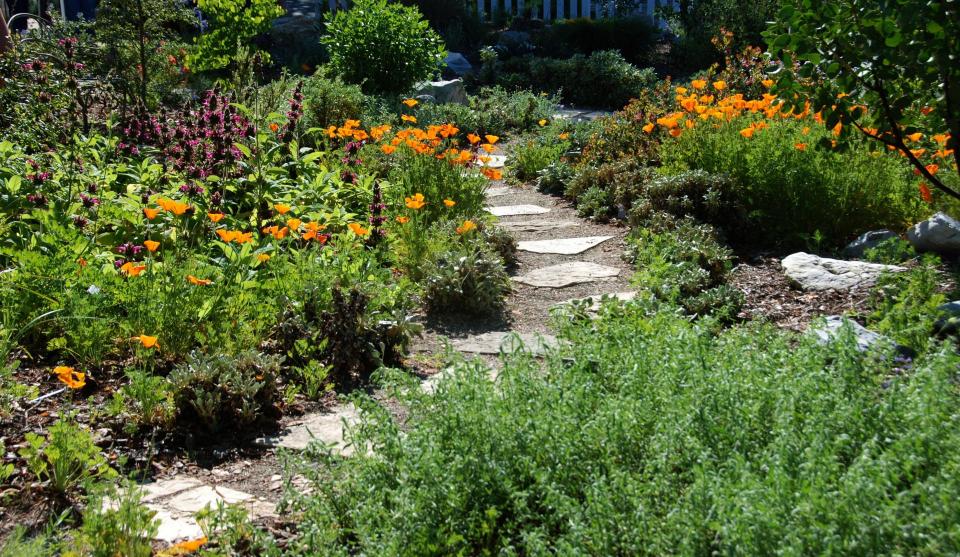Rainwater Capture & Harvesting
Frequently asked questions about rainwater capture and harvesting
What is rainwater capture (or harvesting)?
Rainwater capture refers to the strategic collection of rainwater for use in irrigation or other non-potable uses. Keep in mind that the majority of rain falls during the winter months or early spring in the Tri-Valley and that most rainfall events are less than 2 inches over a 24-hour period for our area.
What systems are typically used for rainwater capture at the household level?
Two of the most typical systems for rainwater capture in homes are rain gardens and rain barrels. Each is an above-ground system that collects water onsite during a rain event.
A rain garden includes specific design elements that allow it to perform well. The area should be low enough for water to flow into and pool slightly, up to approximately 4-6”. Compost should be mixed with the soil and plants need to be carefully selected based on their water use. Often a dry creek bed element with rocks is used at the lowest point of the rain garden and higher areas contain more plants. Plant types and locations need to be selected strategically as the lower elevation plants will receive more water than those at the top of the slope.
Rain Barrels are a great tool for collecting and storing rainwater runoff from roofs. To find the square footage of your roof, multiply the length by width. Multiply that by 0.56 to find gallons per inch of rain. Then multiply by average inches of rain for your area to find an appropriate rain barrel volume—the Tri-Valley area gets about 14 inches of rain per year on average. A downspout from the roof should be connected to the barrel to collect the water from the roof and gutters should be cleaned regularly. You can often find kits to help with setting up rain barrels that include components such as a screen to prevent debris from entering the barrel and a spout to easily access the water for irrigation. Any overflow from your barrel should be directed away from your home and toward a rain garden or drain. Irrigation from a rain barrel may not be recommended for vegetable gardens.
Are there regulatory requirements for rainwater capture?
California residents are allowed to capture rainwater from their roofs for use in gardening, landscaping, and other non-potable uses according to the Rainwater Recapture Act of 2012.
Why capture or harvest rainwater?
Landscaping irrigation is often the single biggest category of urban water use, accounting for up to 70% of total water urban use, particularly in warmer inland areas like the Tri-Valley. Ideal for irrigating landscaping, rainwater capture can make good use of water that typically runs off into storm drains.
Rainwater capture helps preserve drinking water supplies by limiting the amount needed for landscape irrigation or other non-potable uses. Reusing this local water source reduces dependency on imported water.
Captured rainwater requires no treatment. Simple rain barrels can be inexpensive to install and typically do not require a permit.
Rainwater capture systems can reduce overall water consumption and potentially your water bill.
Rainwater capture connects us to our water supply, helping us understand where our water comes from and where it goes and helping us become better stewards of our watershed.
Rainwater capture via rain gardens allows some of the water to absorb into the soil and eventually percolate down into the groundwater supply, contributing to long-term water supply for our area.
A limitation of rainwater capture in California is the distinct wet and dry seasons. Generally, this means that one can capture rainwater during the wet season—when it’s less likely needed for irrigation—and have no rainwater to capture during the dry season when irrigation water would be helpful. However, any rainwater captured during the wet season can still be used for non-potable, non-irrigation needs such as indoor plant watering, flushing toilets, and washing cars.
Are there rebates available for rainwater capture systems?
Currently, there are no rebates for rainwater capture systems in the Tri-Valley due to the nature and duration of the rain events. Zone 7 Water Agency, the wholesale water agency in the Tri-Valley, will continue to work with the local water retailers to explore if a regional rebate program for rainwater capture should be developed in the future. For information about rebates on offer, go to www.zone7water.com/rebate-program.
Other Resources
- East Bay Municipal Utility District – Rainwater Harvesting Information Page
- East Bay Municipal Utility District – Rainwater Catchment Presentation
- San Francisco Public Utilities Commission – How to Build Your Own Rain Barrel System Video
- Contra Costa Water District Rain – Gardens and Rainwater Harvesting Information Page
- Federal Energy Management Program – Rainwater Harvesting Systems Information Page

